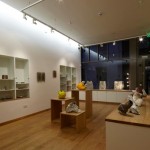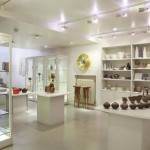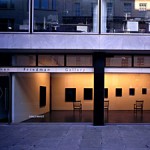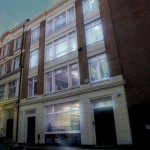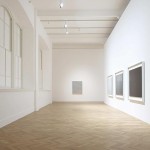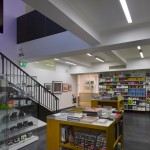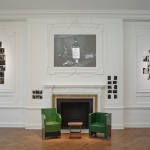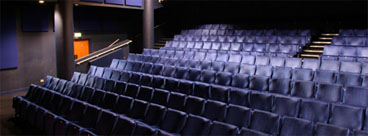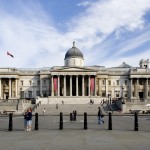大英博物館The British Museum
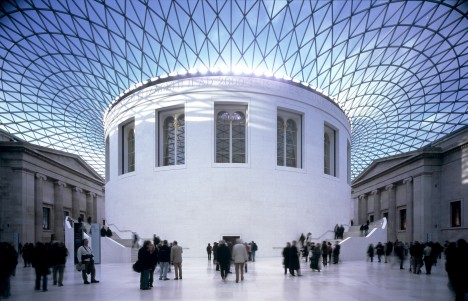
© The British Museum
Every day Great Russell Street in London is a bustling road full of people from all walks of life, however in a city which has many busy areas full of pedestrians there is something a bit more uniqueロンドンのグレートルッセル通りは毎日人で賑わっている。通行人で溢れるエリアが多いこの町だが、ここは少し他とは違う。通りのほとんどの人間が同じ場所に向かっているのだ。ビルの並ぶ通りの反対側に印象的な建物がある。建物のサイズ、柵、そのクラシックな造りから古いお寺ではないかと考えてしまうかもしれない。沢山の観光を目的に訪れたツアー団体や、学生など、人々についていき、巨大な柱でできた正面玄関を通れば、世界で名高い大英博物館にたどり着く。
![]()
1753年に設立され、過去259年間、考古工芸品の保存や、世界中の古代から現代の文化の展示、そして数々のイベントを行ってきた。創設からの長い歴史からわかるように大英博物館は多くのコレクションを所蔵している。その外観の大きさは鑑賞のために長い滞在が必要である事を物語っている。建物はアメリカ大陸、古代エジプト、古代ギリシャ/ローマ、アジア、中東などのセクションや、啓蒙や生きることと死んでいくことなどテーマのセクション、そして特別展のセクションに分かれている。グレート・コートと図書室は正面玄関を入ってまっすぐ進んだ所にある、博物館のユニークなエリアの一つだ。
![]()
現在はロード・フォスターの1990年の設計で鋼鉄とガラスの屋根で囲まれた巨大スペースになっているが、過去は戸外の中庭で1850年に工事が行なわれ、中央に博物館が集めた本のコレクションを置く図書室を建設した。カール・マークスやレーニン、ブラム・ストーカーやアーサー・コナン・ドイルも訪れたことのあるグレート・コートの中央に位置する図書室では、現在も2万5千冊以上ある本や随時行なわれる展示は一般市民に解放されている。
![]()
作品はどれも素晴らしく全ての作品をじっくり鑑賞できればよいのだが、博物館ではこれらの作品の全てをじっくりと見る事は不可能だろう。その中でも一際素晴らしい物はもちろんあるもので、例えばロゼッタ・ストーン、この考古工芸品は1799年に発見され、書かれている文字は当時のエジプトの統治者による法令だが、大切なのはそこに同じ法例が3度、3種類の言語で書かれている事。エジプトの表意文字を解読するヒントになっている。
![]()
関連する展示は有名なエジプトのミイラなど(3千年前に埋められて以来まだ一度も開けられておらずケースに横たわっているもの)。この展示は、物としての作品のコレクションを見ているのではなく、人間の歴史を見ているのだということを来館者に思い出させてくれる。人は生き、そして遺跡を残して死んでいったのだ。来館者はエジプトの展示エリアでは歴史を重んじて静かに話している様だ。
![]()
古代の人の顔など、そこにはそれらをリアルに体感できる雰囲気がある。この博物館では、私たち現代人の創造のためだけの創造に比べ、著しく困難な人生を生きているにも関わらずつくり出された、信じられない程芸術性の高い作品の数々を見ることができる。日本の明治維新の時代に作られた鉄製の動物の模型も展示されている。サク・ムネアキによるザリガニなど、曲線状の金属でできた動物たちは可動式だ。
![]()
大英博物館への訪問には一日いっぱいを費やす事になるので慎重に計画を立てる事をお勧めする。フロアプランは必須であるし、事前のホームページの活用も良いだろう。無料の展示もたびたび行なわれおり、今年は2012年ロンドンオリンピックのメダルとウィリアム・シェイクスピアの特別展が行なわれる。スペシャルトーク、映像、ボランティアガイドによる無料の説明も一日を通して行われている。博物館内にあるレストランやカフェも、素晴らしい一日を過ごすには欠かせない。
![]()
The British Museum
住所:Great Russell Street, London WC1B 3DG
営業時間:10:00〜17:30(金曜日20:30まで)
TEL:+44 (0)20 7323 8299
information@britishmuseum.org
http://www.britishmuseum.org
![]()
Text: Michael Sullivan
Translation: Meiko Maruyama in this location and in fact most, if not all, of the people are heading to the same location. Opposite the row of buildings along one side of the road is a very impressive structure, the sheer size of the building, as well as the perimeter fence, could lead you to believe it is an ancient temple as it has been built in a classical style. However, if you follow one of the many groups of tourists, schoolchildren or smaller groups, and pass through the huge columns that make up the front entrance’s façade, you will find yourself in the world renowned British Museum.
![]()
Established in 1753, for the past 259 years it has been dedicated to the preservation of artefacts, exhibitions of ancient and contemporary cultures from around the world, as well as to staging numerous events. As can be expected as the British Museum has been established for so long it has acquired a huge collection of artefacts and just as big as it looks on the outside does mean that a long visit has to be planned. The building has been divided into sections including the Americas, Ancient Egypt, Ancient Greece and Rome, Asia, the Middle East, Themes (such as Enlightenment, and Living and Dying), and special exhibitions.
![]()
Upon entering through the main entrance and heading straight forward you will find yourself in perhaps one of the most unique areas of the museum: the Great Court and Reading Room. This impressive area was once an open air courtyard but in the 1850s a building was constructed in its centre, the Reading Room, which was designed to house the museum’s collection of books, in the 1990s this was redeveloped by Lord Foster and the courtyard gained a glass and steel roof creating a massive enclosed space. The Reading Room has remained in the centre of the Great Court, this famous structure which has had visits from people as diverse as Karl Marx, Lenin, as well as Bram Stoker and Sir Arthur Conan Doyle, is open to everyone and contains over 25,000 books and regularly holds exhibitions.
![]()
As this museum has so much to see it is impossible to do justice to everything and give an in-depth overview, the number of items on display is astounding and in truth every each one of them deserves a moment of consideration. There are a number of items that do stand out however, such as the Rosetta Stone. This artefact was discovered in 1799, and although the writing is only concerning a decree by the ruler of Egypt, its extreme importance lies in the fact that it has the same decree three times in three different languages, thus allowing us to decipher the meanings of Egyptian hieroglyphs.
![]()
A related number of exhibits are the famous Egyptian mummies, some of which still lie in their cases and have not been opened since they were buried nearly 3,000 years ago. This helps to remind visitors that they are looking at human history rather than a collection of objects, people lived and died many years ago and left us their remains, hence in this part of the Egyptian exhibit people tend to talk in respectful hushed tones. There is a tangible atmosphere as the human face of the past becomes very real. Throughout the museum there are items of incredible artistry, despite living lives significantly harder than our own people have always managed to create just for the sake of creation. One exhibit shows iron models of animals made in Japan during the Meiji Restoration, these amazing creatures, such as the crayfish by Muneaki Saku, are made out of curved pieces of metal and can be moved into different positions.
![]()
A visit to the British Museum will literally keep you occupied all day and should be planned carefully; a floor plan is an essential item as well as using the website beforehand. There are often free exhibitions, for example, this year you can see the London 2012 Olympic medals and there is a special exhibition about William Shakespeare. There are also special talks, films, and also free talks by volunteer guides throughout the day. Inside the museum there are restaurants and cafes, which are really needed when you spend a whole day visiting this fascinating place.
![]()
The British Museum
Address: Great Russell Street, London WC1B 3DG
Opening Hours: 10:00-17:30 (Friday till 20:30)
Tel: +44 (0)20 7323 8299
information@britishmuseum.org
http://www.britishmuseum.org
![]()
Text: Michael Sullivan
